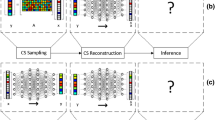Abstract
A new form of the multivariate median is introduced. It is defined as a point in the multidimensional space whose sum of distances from a set of multidimensional hyperplanes is minimal. This median can be used to formulate and solve the problem of sparse signal reconstruction. Application of the proposed multivariate median is illustrated on examples.





Similar content being viewed by others
References
G.R. Arce, J.L. Parades, Recursive weighted median filters admitting negative weights and their optimization. IEEE Trans. Signal Process. 48(3), 768–779 (2000)
J. Astola, P. Haavisto, Y. Neuvo, Vector median filters. Proc. IEEE 78(4), 678–689 (1990)
R. Chelouaha, P. Siarry, Genetic and Nelder–Mead algorithms hybridized for a more accurate global optimization of continuous multiminima functions. Eur. J. Oper. Res. 148(2), 335–348 (2003)
I. Djurović, L. Stanković, J.F. Böhme, Robust L-estimation based forms of signal transforms and time-frequency representations. IEEE Trans. Signal Process. 51(7), 1753–1761 (2003)
D.L. Donoho, M. Gasko, Breakdown properties of location estimates based on halfspace depth and projected outlyingness. Ann. Stat. 20(4), 1803–1827 (1992)
W. Hu, K. Wu, P.P. Shum, N.I. Zheludev, C. Soci, All-optical implementation of the ant colony optimization algorithm. Sci. Reports (2016). https://doi.org/10.1038/srep26283
P.J. Huber, E.M. Ronchetti, Robust statistics, 2nd edn. (Wiley, Hoboken, 2009)
V. Katkovnik, Robust M-periodogram. IEEE Trans. Signal Process. 46, 3104–3109 (1998)
S. Kirkpatrick, C.D. Gelatt, M.P. Vecchi, Optimization by simulated annealing. Science 220(4598), 671–680 (1983). https://doi.org/10.1126/science.220.4598.671
J. Larson, S.M. Wild, A batch, derivative-free algorithm for finding multiple local minima. Optim. Eng. 17(1), 205–228 (2016). https://doi.org/10.1007/s11081-015-9289-7
V.V. Lukin, S.K. Abramov, V.V. Abramova, J.T. Astola, K.O. Egiazarian, DCT-based denoising in multichannel imaging with refrence. Telecommun. Radio Eng. 75(13), 1167–1191 (2016)
A. Neumaier, Complete search in continuous global optimization and constraint satisfaction. Acta Numer. 13(1), 271–369 (2004)
D. Pršić, N. Nedić, V. Stojanović, A nature inspired optimal control of pneumatic-driven parallel robot platform. Proc. Inst. Mech. Eng. Part C J. Mech. Eng. Sci. 231(1), 59–71 (2017)
A. A. Roenko, V. V. Lukin, and I. Djurović, An overview of the adaptive robust DFT, EURASIP J Advances Signal Process., Special issue robust processing of nonstationary signals, 2010, (Article ID 595071), 17 pages, (2010)
J.C. Spall, Introduction to stochastic search and optimization (Wiley, Hoboken, 2005). (ISBN 0-471-33052-3)
L. Stanković, M. Daković, On a gradient-based algorithm for sparse signal reconstruction in the signal/measurements domain. Math. Probl. Eng. 2016, 1–11 (2016). (Article ID 6212674)
L. Stanković, M. Daković, S. Vujović, Reconstruction of sparse signals in impulsive disturbance environments. Circuits Syst. Signal Process. 36(2), 767–794 (2017)
L. Stanković, D. Mandić, M. Daković, M. Brajović, Time-frequency decomposition of multivariate multicomponent signals. Signal Process. 142, 468–479 (2018)
V. Stojanović, V. Filipovic, Adaptive input design for identification of output error model with constrained output. Circuits Syst. Signal Process. 33(1), 97–113 (2014)
V. Stojanovic, N. Nedic, A nature inspired parameter tuning approach to cascade control for hydraulically driven parallel robot platform. J.Optim. Theory Appl. 168(1), 332–347 (2016)
V. Stojanović, N. Nedić, Robust identification of OE model with constrained output using optimal input design. J. Franklin Inst. 353(2), 576–593 (2016)
Y. Vardi , C.H. Zhang The multivariate L1-median and associated data depth. in Proceedings of the national academy of sciences of the United States (PNAS)
M. Welk Multivariate median filters and partial differential equations (March 2016). arXiv:1509.08082v2
Author information
Authors and Affiliations
Corresponding author
Rights and permissions
About this article
Cite this article
Stanković, L., Daković, M. Compressive Sensing Inspired Multivariate Median. Circuits Syst Signal Process 38, 2369–2379 (2019). https://doi.org/10.1007/s00034-018-0955-9
Received:
Revised:
Accepted:
Published:
Issue Date:
DOI: https://doi.org/10.1007/s00034-018-0955-9




